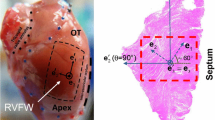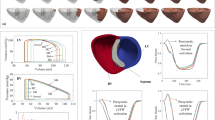Abstract
Recent morphological studies have demonstrated a laminar (sheet) organization of ventricular myofibers. Multiaxial measurements of orthotropic myocardial constitutive properties have not been reported, but regional distributions of three-dimensional diastolic and systolic strains relative to fiber and sheet axes have recently been measured in the dog heart by Takayama et al. [30]. A three-dimensional finite-deformation, finite element model was used to investigate the effects of material orthotropy on regional mechanics in the canine left ventricular wall at end-diastole and end-systole. The prolate spheroidal model incorporated measured transmural distributions of fiber and sheet angles at the base and apex. Compared with transverse isotropy, the orthotropic model of passive myocardial properties yielded improved agreement with measured end-diastolic strains when: (1) normal stiffness transverse to the muscle fibers was increased tangent to the sheets and decreased normal to them; (2) shear coefficients were increased within sheet planes and decreased transverse to them. For end-systole, orthotropic passive properties had little effect, but three-dimensional systolic shear strain distributions were more accurately predicted by a model in which significant active systolic stresses were developed in directions transverse to the mean fiber axis as well as axial to them. Thus the ventricular laminar architecture may give rise to anisotropic material properties transverse to the fibers with greater resting stiffness within than between myocardial laminae. There is also evidence that intact ventricular muscle develops significant transverse stress during systole, though it remains to be seen if active stress is also orthotropic with respect to the laminar architecture.
Similar content being viewed by others
References
O. Cazorla, J. Le Guennec and E. White, Length-tension relationships of sub-epicardial and sub-endocardial single ventricular myocytes from rat and ferret hearts. J. Mol. Cell Cardiol. 32 (2000) 735–744.
K.D. Costa, P.J. Hunter, J.M. Rogers, J.M. Guccione, L.K. Waldman and A.D. McCulloch, A three-dimensional finite element method for large elastic deformations of ventricular myocardium: Part I-cylindrical and spherical polar coordinates. ASME J. Biomech. Engng. 118 (1996) 452–463.
K.D. Costa, P.J. Hunter, J.S. Wayne, L.K. Waldman, J.M. Guccione and A.D. McCulloch, A three-dimensional finite element method for large elastic deformations of ventricular myocardium: Part II-Prolate spheroidal coordinates. ASME J. Biomech. Engng. 118 (1996) 464–472.
K.D. Costa, Y. Takayama, A.D. McCulloch and J.M. Covell, Laminar fiber architecture and three-dimensional systolic mechanics in canine ventricular myocardium. Am. J. Physiol. 276 (Heart Circ. Physiol. 45) (1999) 595–607.
J.M. Guccione and A.D. McCulloch, Finite element modeling of ventricular mechanics. In: L. Glass, P.J. Hunter and A.D. McCulloch (eds), Theory of Heart: Biomechanics, Biophysics, and Nonlinear Dynamics of Cardiac Function, Springer, New York (1991), pp. 121–144.
J.M. Guccione and A.D. McCulloch, Mechanics of active contraction in cardiac muscle: Part I-constitutive relations for active fiber stress that describe deactivation. ASME J. Biomech. Engng. 115 (1993) 72–81.
J.M. Guccione, K.D. Costa and A.D. McCulloch, Finite element stress analysis of the left ventricular mechanics in the beating dog heart. J. Biomechanics 28 (1995) 1167–1177.
R.M. Huisman, G. Elzinga, N. Westerhof and P. Sipkema, Measurement of left ventricular wall stress. Cardiovasc. Res. 14 (1980) 142–153.
J.D. Humhrey and F.C.P. Yin, On constitutive relations and finite deformations of passive cardiac tissue: II. Stress analysis in the left ventricle. Circ. Res. 65 (1989) 805–817.
P.J. Hunter, A.D. McCulloch and H.E.D.J. ter Keurs, Modeling the mechanical properties of cardiac muscle. Progress in Biophysics & Molecular Biology 69 (1998) 289–331.
B.Ya. Kantor, M.I. Yabluchansky and T.P. Usyk, Cubic potential of the transversely isotropic material taking into account the shear deformation. School of Fundamental Medicine J. 1 (1995) 14–18.
B.Ya. Kantor, M.I. Yabluchansky and T.P. Usyk, The mathematical model of the left ventricle by transversely isotropic body of revolution. School of Fundamental Medicine J. 3 (1997) 19–23.
B.Ya. Kantor, M.I. Yabluchansky and T.P. Usyk, The left ventricle mechanics (transversely isotropic body of revolution). In: Proceedings of the 11th Conference of the European Society of Biomechanics, 8–11 July 1998, Toulouse, France, J. Biomech. 31, Suppl. 1 (1998), p. 78.
W.L. Karlon, Influence of myocardial fiber organization on ventricular function, Ph.D. Thesis, UC San Diego, La Jolla, CA (1998).
I.J. LeGrice, B.H. Smill, L.Z. Chai, S.G. Edgar, J.B. Gavin and P.J. Hunter, Laminar structure of the heart: Ventricular myocyte arrangement and connective tissue architecture in the dog. Am. J. Physiol. 269 (1995) 571–582.
I.J. LeGrice, Y. Takayama and J.W. Covell, Transverse shear along myocardial cleavage planes provides a mechanism for normal systolic wall thickening. Circ. Res. 77 (1995) 182–193.
D.H.S. Lin and F.C.P. Yin, A multiaxial constitutive law for mammalian left ventricular myocardium in steady-state barium contracture of tetanus. ASME J. Biomech. Engng. 120 (1998) 504–517.
K.D. May-Newman, J.H. Omens, R.S. Pavelec and A.D. McCulloch, Three-dimensional transmural mechanical interaction between the coronary vasculature and passive myocardium in the dog. Circ. Res. 74 (1994) 1166–1178.
R. Mazhari and A.D. McCulloch, Three-dimensional mechanics of myocardial contraction: mechanisms of transverse systolic stress. In: Proceeding of ASME 4th Summer Bioengineering Conference (1999), pp. 43–44.
P.M.F. Nielsen, I.J. LeGrice, B.H. Smaill and P.J. Hunter, Mathematical model of geometry and fibrous structure of the heart. Am. J. Physiol. 260 (Heart Circ. Physiol. 29) (1991) 1365–1378.
V.P. Novak, F.C.P. Yin and J.D. Humphrey, Regional mechanical properties of passive myocardium. J. Biomech. 27 (1994) 403–412.
W. O'Dell, C. Moore, W. Hunter, E. Zerhouni and E. McVeigh, Displacement field fitting approach to calculate 3D deformations from parallel-tagged MR images. Radiology 195 (1995) 829–835.
W. O'Dell, J. Schoeniger, S. Blackband and E. McVeigh, A modified quadrapole gradient set for use in high resolution MRI tagging. Magnetic Resonance in Medicine 32 (1994) 246–250.
J.H. Omens, K.D. May and A.D. McCulloch, Transmural distribution of three-dimensional strain in the isolated arrested canine left ventricle. Am. J. Physiol. 261 (1991) 918–928.
S.H. Peng and W.V. Chang, A compressible approach in finite element analysis of rubber-elastic materials. Computers & Structures 62 (1997) 573–593.
M. Schoenberg, Geometric factors influencing muscle force development, II. Radial forces. Biophys. J. 30 (1980) 51–68.
H.M. Spotnitz, W.D. Spotnitz, T.S. Cotrell, D. Spiro and E.H. Sonnenblick, Celluar basis for volume-related wall thickness changes in the rat left ventricle. J. Mol. Cell Cardiol. 6 (1974) 317–331.
D.D. Streeter, Jr., Gross morphology and fiber geometry of the heart. In: Handbook of Physiology, Section 2: The Cardiovascular System, Chapter 4. M BR. Bethesda, MD, American Physiological Society, I: 61.
D.D. Streeter, Jr., H.M. Spotnitz, D.P. Patel, J. Ross, Jr. and E.H. Sonnenblick, Fiber orientation in the canine left ventricle during diastole and systole. Circ. Res. 24 (1969) 339–347.
Y. Takayama, K.D. Costa and J.W. Covell, Contribution of laminar myofiber architecture to load dependent changes in the mechanics of the left ventricular myocardium (submitted).
F.J. Vetter and A.D. McCulloch, Three-dimensional stress and strain in passive rabbit left ventricle: A model study. Ann. Biomed Eng. 28 (2000) 781–792.
F.C.P. Yin, R.K. Strumpf, P.H. Chew and S.L. Zeger, Quantification of the mechanical properties of noncontracting canine myocardium under simultaneous biaxial loading. J. Biomech. 20 (1987) 577–589.
G.I. Zahalak, Non-axial muscle stress and stiffness. J. Theoret. Biology 182 (1996) 59–84.
Author information
Authors and Affiliations
Rights and permissions
About this article
Cite this article
Usyk, T., Mazhari, R. & McCulloch, A. Effect of Laminar Orthotropic Myofiber Architecture on Regional Stress and Strain in the Canine Left Ventricle. Journal of Elasticity 61, 143–164 (2000). https://doi.org/10.1023/A:1010883920374
Issue Date:
DOI: https://doi.org/10.1023/A:1010883920374




